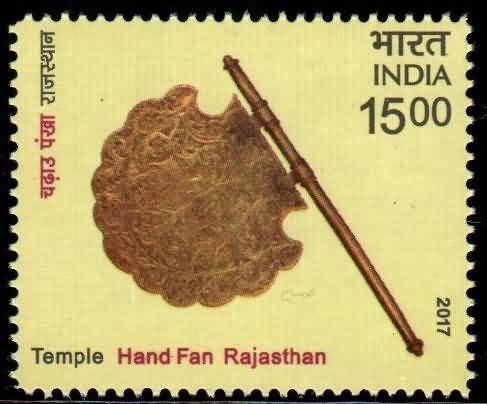Temple Hand Fan, Rajasthan

Technical Data
| Date of Issue | December 30, 2017 |
|---|---|
| Denomination | Rs. 15 |
| Quantity | 100,000 |
| Perforation | 13 |
| Printer | India Security Press, Nashik |
| Printing Process | Wet Offset |
| Watermark | No Watermark |
| Colors | Multicolor |
| Credit (Designed By) | Ms. Nenu Gupta Shri. jatin Das |
| Catalog Codes |
Michel IN 3317 Yvert et Tellier IN 3008 Stanley Gibbons IN 3443 |
| Themes | Crafts |
A Sacred Symbol of Devotion and Craftsmanship
Introduction
The Temple Hand Fan is one of India’s most revered traditional fan forms, deeply rooted in the country’s spiritual and artistic heritage. Crafted with devotion and used exclusively in temples, these hand fans are offered to deities as a mark of respect, purity, and ceremonial elegance. The Temple Hand Fan, prominently made in Rajasthan and other parts of India, reflects a unique blend of religious symbolism, intricate metalwork, and age-old craftsmanship.
Historical and Cultural Significance
Hand fans have played an important role in Indian rituals since ancient times, with references found in sacred texts, including the Mahabharata. In temples, fans are not used for comfort; they are sacred items meant to honor and cool the deity, symbolizing humility and service.
The Temple Hand Fan became an integral part of temple traditions, especially in royal and devotional regions like Rajasthan, where metalwork flourished. Offering a hand fan is considered an act of worship and devotion, representing the desire to serve the divine with love and reverence.
Craftsmanship and Design
The Temple Hand Fan is typically crafted from engraved brass, often featuring a long handle for ease of ceremonial movement. The metal surface is adorned with delicate patterns, motifs of gods and goddesses, floral engravings, and symbolic designs that reflect the artistic heritage of Rajasthan.
Each fan is shaped to enable smooth, rhythmic movement during temple rituals, creating a gentle breeze believed to bring comfort to the deity and purify the surroundings. The craftsmanship demands precision, patience, and a deep understanding of religious aesthetics.
Role in Temple Rituals
These ornate fans are used during aarti, daily worship, seasonal rituals, and major festivals. Priests gently wave the fan before the deity as a gesture of honor, care, and spiritual reverence. The presence of such fans highlights the grandeur and sanctity of traditional Indian temple worship.
Commemorative Postage Stamp
The Department of Posts has celebrated India’s rich legacy of hand fans by issuing a commemorative postage stamp series on Indian Hand Fans, featuring 16 traditional varieties. The Temple Hand Fan is one of the distinguished items included in this collection.
The stamp beautifully showcases the ornate brasswork, elegant handle, and ceremonial design, paying tribute to the artisans and temple communities who have preserved this sacred tradition.
Enduring Legacy
The Temple Hand Fan stands as a timeless symbol of India’s devotional culture and artistic mastery. More than an object, it embodies centuries of faith, ritual, and craftsmanship. Through its inclusion in the commemorative stamp series, this sacred artefact is forever etched in India’s philatelic heritage—honoring the craft, ritual significance, and spiritual devotion it represents.
